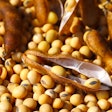The benefits and challenges of feeding pigs dried distiller’s grains with solubles, DDGS, are well known: Attractive pricing versus the general issues with maize (nutrient variability, mycotoxins, soft carcass fat, unbalanced protein). Yet, with careful planning and smart diet formulation, it is possible to use high levels of DDGS in diets for all classes of pigs. In some cases, up to 40 percent has been added to pig diets.
In my experience, a moderate DDGS level around 20 percent has not caused any problems, after taking into account the above known issues. As prices for cereals and protein sources continue to increase, there is considerable pressure for higher DDGS levels to be used even in piglet prestarter diets, which is usually restricted.
Thus, the question becomes, “how much DDGS is too much in an animal’s diet?”
In the past, this was easily answered by bringing into conversation the issue of variability due to manufacturing. Today such processes have been standardized with considerable reduction in undesirable variability of nutrient concentration and more importantly nutrient digestibility.
In my opinion, assuming a high-quality feed product is available, using up to 30 percent DDGS should not be excluded as an option in most pig diets.
So, what about using higher levels of DDGS in pig diets? There is a great number of research available, but very little discussion based on practical experiences—good or bad! It would be great to start such a discussion here. Please leave a comment!


















